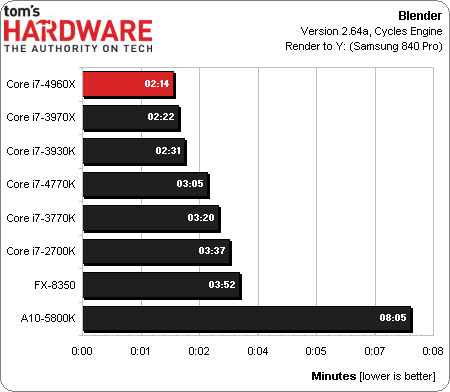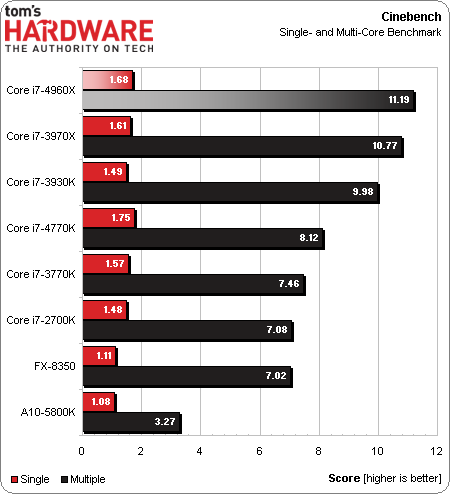Intel Core i7-4960X Review: Ivy Bridge-E, Benchmarked
Results: Content Creation
Both of our 3ds Max benchmarks favor Intel’s hexa-core processors, and the Ivy Bridge architecture is enough to earn Core i7-4960X the top spot yet again. Core i7-3970X isn’t far behind though, and it’s not hard to imagine an overclocked Core i7-3930K topping both flagship chips.
There’s a fairly consistent pattern in play. Threaded workloads that would have favored Sandy Bridge-E are just a few percent faster on Ivy Bridge-E. In this case, we’re looking at about a 5% speed-up. All three LGA 2011-based CPUs are quite a bit quicker than the LGA 1150/1155-based models.
Based on Maxon’s Cinema 4D software, our scripted Cinebench test measure single- and multi-core processor performance.
Clearly, the threaded component of this benchmark favors Ivy Bridge-E, as Intel’s Core i7-4960X turns in a score 4% higher than the -3970X. And although Ivy Bridge-E also demonstrates an advantage over Sandy Bridge-E in the single-core metric, Haswell demonstrates the top result when we isolate one thread.
Get Tom's Hardware's best news and in-depth reviews, straight to your inbox.
Current page: Results: Content Creation
Prev Page Results: Adobe CS6 Next Page Results: Productivity-
Someone Somewhere Probably would have been nice to be 8-core. Isn't the actual die on these things just a cut-down 12-core chip? Think I read that somewhere.Reply
EDIT: Minor error:
surface alongside Haswell-based 9-series chipsets
Shouldn't that be Broadwell? -
designasaurus There's a rumor going around that Ivy-E is going to have a soldered heatspreader instead of using thermal paste. Obviously this would be a big differentiator for enthusiasts picking between Haswell and Ivy-E. Given your access to Ivy-E, do you guys at Tom's have any opinions on this rumor?Reply -
killerchickens I bet it overclocks like a beast. :)Reply
Lol now time to spend $1000 to save on my power bill. -
ingtar33 about all i'd expect. shame really, but it looks like the enthusiast market is at a standstill till AMD starts to compete again.Reply -
sna too early to judge...Reply
The 6 cores ivyBridge-e "K" version is the real thing.
and I dont get it , how Tomshardwae fails to say about the SandyBridge-e not having PCIE 3.0 support , while the ivy-E has PCIe 3.0 support . this is a Big factor here. -
ingtar33 Reply11172422 said:too early to judge...
The 6 cores ivyBridge-e "K" version is the real thing.
and I dont get it , how Tomshardwae fails to say about the SandyBridge-e not having PCIE 3.0 support , while the ivy-E has PCIe 3.0 support . this is a Big factor here.
they did say it. You didn't read the beginning of the review. Of course pci-e 3.0 is a gimmick and not a reason to buy a new 2011 mb and ib-e chip... and it will remain a marketing gimmick untill gpus can actually be bottlenecked by pci-e 2.0 x16... high end gpus barely bottleneck on pci-e 2.0 x8 atm... it will be a little while (another generation or 3) before gpus will NEED pci-e 3.0.
-
Someone Somewhere Replyofficial PCI Express 3.0 compliance (remember, Sandy Bridge-E only claimed 8 GT/s signaling support), and 22 nm manufacturing.
That's pretty much saying it did it unofficially.
Besides, you have to look hard to find something bottlenecked by PCIe2.0x8; even high-end GPUs won't run into bandwidth limitations. -
CommentariesAnd More WOW !!!!!!! So Intel is expecting someone to spend another 1000 bucks just for a 10-20% boost. Yay!!!!!!!! This is Ivy Bridge-E. I am getting it , YAY!!!!!!!!!!!!!Reply -
shin0bi272 still no gaming benchmarks eh? I guess I'll save my money and stick with my i7-920 for a little bit longer.Reply



